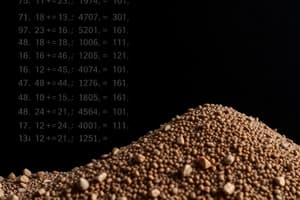Podcast
Questions and Answers
What is a heap?
What is a heap?
A specialized tree-based data structure that satisfies the heap property.
In a binary heap, the left child of a node at index i is found at index _____
In a binary heap, the left child of a node at index i is found at index _____
2i + 1
In a binary heap, the right child of a node at index i is found at index _____
In a binary heap, the right child of a node at index i is found at index _____
2i + 2
What is the time complexity of building a max-heap?
What is the time complexity of building a max-heap?
Which algorithm is generally faster on average for sorting arrays?
Which algorithm is generally faster on average for sorting arrays?
Radix Sort sorts numbers based on each digit starting from the most significant digit.
Radix Sort sorts numbers based on each digit starting from the most significant digit.
What is the purpose of the Master Theorem?
What is the purpose of the Master Theorem?
The time complexity of Counting Sort is _____
The time complexity of Counting Sort is _____
What is the worst-case time complexity of QuickSort?
What is the worst-case time complexity of QuickSort?
Which data structure allows for O(1) access time?
Which data structure allows for O(1) access time?
Dijkstra's Algorithm can be used for graphs with negative weights.
Dijkstra's Algorithm can be used for graphs with negative weights.
Define the term 'Big O' notation.
Define the term 'Big O' notation.
In the Fractional Knapsack problem, the items are sorted by _____
In the Fractional Knapsack problem, the items are sorted by _____
What is the time complexity of the 0-1 Knapsack problem using dynamic programming?
What is the time complexity of the 0-1 Knapsack problem using dynamic programming?
Flashcards are hidden until you start studying
Study Notes
Heaps and HeapSort
- A heap is a specialized tree structure that satisfies the heap property.
- In a max-heap, each parent node is greater than or equal to its children; in a min-heap, each parent is less.
- A binary heap is commonly implemented as an array.
- Parent index: floor((i−1)/2)
- Left child index: 2i + 1
- Right child index: 2i + 2
HeapSort
- Construct a max-heap from input data.
- Swap the root (maximum value) with the last item of the heap.
- Reduce heap size by one and heapify the root; repeat until the heap is empty.
- Time complexity for building the heap: O(n)
- Heapify operation time complexity: O(log n)
- Overall time complexity: O(n log n)
QuickSort
- Select a pivot element from the array.
- Partition the array into two halves based on the pivot values (less than and greater).
- Recursively sort the two halves.
- Best and average case time complexity: O(n log n)
- Worst-case time complexity: O(n^2), occurs with poor pivot choices on sorted arrays.
MergeSort
- Divide the array into two halves.
- Recursively sort each half.
- Merge the sorted halves back to form a sorted array.
- Time complexity is consistently O(n log n) for all cases.
Radix Sort
- Sort numbers based on each digit, from least significant to most significant.
- Utilize a stable sort (like Counting Sort) for sorting based on each digit.
- Time complexity: O(d(n + k)), where d is the number of digits and k is the range of digit values.
Counting Sort
- Count occurrences of each element.
- Compute positions for each element in the sorted array.
- Place elements in correct positions based on counts.
- Time complexity: O(n + k), where k is the range of input values.
Divide and Conquer Strategies
- Technique that breaks a problem into smaller subproblems, solves each independently, and combines their solutions.
- Examples include MergeSort, QuickSort, and Binary Search.
Greedy Algorithms
- Makes locally optimal choices at each step to solve optimization problems.
- Examples: Kruskal's Algorithm (MST), Prim's Algorithm (MST), Dijkstra's Algorithm (shortest paths).
- Suitable for problems with the greedy-choice property and optimal substructure.
Master Theorem
- A formula for solving recurrences of the form T(n)=aT(n/b)+f(n).
- Case when f(n)=O(n^c) and c > log_b(a): T(n)=O(f(n)).
Runtimes for Sorts
- Bubble Sort: O(n^2)
- Insertion Sort: O(n^2)
- Selection Sort: O(n^2)
- MergeSort: O(n log n)
- QuickSort: Average O(n log n), Worst O(n^2)
- HeapSort: O(n log n)
- Counting Sort: O(n + k)
- Radix Sort: O(d(n + k))
Runtimes for Data Structures
- Arrays: Access O(1), Search O(n), Insertion/Deletion O(n)
- Linked Lists: Access O(n), Search O(n), Insertion/Deletion O(1)
- Hash Tables: Access O(1), Search O(1), Insertion/Deletion O(1)
- Binary Search Trees: Access O(log n), Search O(log n), Insertion/Deletion O(log n)
- Heaps: Access O(1), Search O(n), Insertion/Deletion O(log n)
Fractional Knapsack
- Goal: Maximize total value by taking fractions of items with weights and values.
- Solution involves sorting items by value-to-weight ratio before selection.
- Time complexity is O(n log n) due to sorting.
0-1 Knapsack
- Goal: Maximize total value without breaking items.
- Dynamic programming builds a table (dp[i][w]) representing the maximum value for the first i items within weight limit w.
- Time complexity: O(nW), where n is number of items and W is capacity.
Dijkstra's Algorithm
- Aims to find shortest paths from a source vertex to all other vertices in a graph with non-negative weights.
- Uses a priority queue to select the vertex with the smallest distance iteratively.
- Time complexity: O(V^2) with an array, O((V + E) log V) with a priority queue.
Trees
- A tree is a connected acyclic graph, characterized by having n - 1 edges for n vertices.
- Unique path exists between any two vertices in a tree.
Big O Notation and Other Notations
- Big O (O): Defines the upper bound on time complexity.
- Big Omega (Ω): Indicates the lower bound on time complexity.
- Big Theta (Θ): Establishes a tight bound on time complexity.
- Little o (o): Indicates an upper bound that is not tight.
- Little omega (ω): Defines a lower bound that is not tight.
Asymptotic Analysis
- Used to analyze algorithm performance as input size increases.
- Considers worst-case, average-case, and best-case scenarios.
- Notations include Big O (upper bound) and Big Omega (lower bound).
Studying That Suits You
Use AI to generate personalized quizzes and flashcards to suit your learning preferences.




